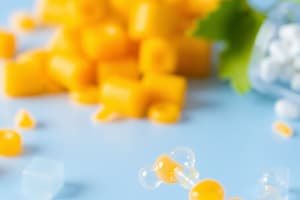Podcast
Questions and Answers
Which of the following is true about carbohydrates?
Which of the following is true about carbohydrates?
- Carbohydrates are derived from animal sources
- Carbohydrates are primarily found in wood
- Carbohydrates are a class of organic compounds (correct)
- Carbohydrates are found only in plants
What is the purpose of starch in grains?
What is the purpose of starch in grains?
- Simple sugar production
- Energy storage (correct)
- Photosynthesis
- Structural material
Which of the following is an example of a monosaccharide?
Which of the following is an example of a monosaccharide?
- Maltose
- Lactose
- Fructose (correct)
- Sucrose
What is the process of converting monosaccharides to alditols called?
What is the process of converting monosaccharides to alditols called?
Which of the following is a property of disaccharides?
Which of the following is a property of disaccharides?
Which polysaccharide is a major component of wood?
Which polysaccharide is a major component of wood?
What is the main source of sucrose?
What is the main source of sucrose?
Which class of compounds in carbohydrates is characterized by their sweetness?
Which class of compounds in carbohydrates is characterized by their sweetness?
Which type of carbohydrate is not sweet but is a condensation product of monosaccharides?
Which type of carbohydrate is not sweet but is a condensation product of monosaccharides?
Which type of carbohydrate is characterized by having a chemical formula of (CH2O)n?
Which type of carbohydrate is characterized by having a chemical formula of (CH2O)n?
Which class of compounds in carbohydrates contains an aldehyde or a ketone functional group?
Which class of compounds in carbohydrates contains an aldehyde or a ketone functional group?
What is the term for carbon atoms in carbohydrates with four different substituents attached to them?
What is the term for carbon atoms in carbohydrates with four different substituents attached to them?
How many stereoisomers are possible for a carbohydrate with n asymmetric carbons?
How many stereoisomers are possible for a carbohydrate with n asymmetric carbons?
What is the term for molecules with a single chiral centre that are chiral?
What is the term for molecules with a single chiral centre that are chiral?
Which of the following statements is true about the Fischer projection of glyceraldehyde?
Which of the following statements is true about the Fischer projection of glyceraldehyde?
Which of the following is true about the D-L classification of monosaccharides?
Which of the following is true about the D-L classification of monosaccharides?
Which of the following is true about the enantiomers of erythrose and threose?
Which of the following is true about the enantiomers of erythrose and threose?
How many stereoisomers are possible for aldopentose?
How many stereoisomers are possible for aldopentose?
Which of the following is true about glucose and mannose?
Which of the following is true about glucose and mannose?
Which of the following is true about glucose and galactose?
Which of the following is true about glucose and galactose?
Which of the following is true about mannose and galactose?
Which of the following is true about mannose and galactose?
Which of the following is true about the D-L classification of ketoses?
Which of the following is true about the D-L classification of ketoses?
What is the result of the reaction between an aldehyde and an alcohol?
What is the result of the reaction between an aldehyde and an alcohol?
What is the name of the cyclic structure formed by the reaction between the aldehyde on carbon 1 and the hydroxyl group on carbon 5 in glucose?
What is the name of the cyclic structure formed by the reaction between the aldehyde on carbon 1 and the hydroxyl group on carbon 5 in glucose?
What is the name of the two anomers formed by the cyclic hemiacetal formation in glucose?
What is the name of the two anomers formed by the cyclic hemiacetal formation in glucose?
What is the predominant form of glucose in a neutral aqueous solution?
What is the predominant form of glucose in a neutral aqueous solution?
What is the best way to represent the cyclic structure of a monosaccharide?
What is the best way to represent the cyclic structure of a monosaccharide?
Which conformation determines the D-L series of a sugar in the Haworth projection?
Which conformation determines the D-L series of a sugar in the Haworth projection?
What are cyclic sugars formed by the C1-C5 hemiacetal called?
What are cyclic sugars formed by the C1-C5 hemiacetal called?
In the case of D-fructose, what is the result of the reaction between the C5 hydroxyl group and the ketone carbonyl in position C2?
In the case of D-fructose, what is the result of the reaction between the C5 hydroxyl group and the ketone carbonyl in position C2?
Flashcards are hidden until you start studying
Study Notes
Carbohydrate Overview
- Carbohydrates are characterized by their sweetness and contain an aldehyde or a ketone functional group.
Monosaccharides
- Monosaccharides are simple sugars and are the building blocks of carbohydrates.
- Examples of monosaccharides include glucose, fructose, and galactose.
- The process of converting monosaccharides to alditols is called reduction.
Disaccharides
- Disaccharides are formed by the condensation of two monosaccharides.
- A property of disaccharides is that they are sweet.
Polysaccharides
- Polysaccharides are formed by the condensation of multiple monosaccharides.
- An example of a polysaccharide is cellulose, which is a major component of wood.
- The chemical formula of polysaccharides is (CH2O)n.
Starch
- Starch is a polysaccharide found in grains and serves as a storage form of energy.
Sucrose
- Sucrose is a disaccharide composed of glucose and fructose.
- The main source of sucrose is sugarcane or sugar beets.
Stereochemistry
- Carbon atoms with four different substituents attached to them are called asymmetric carbons.
- Molecules with a single chiral center that are chiral are called optically active.
- The number of stereoisomers possible for a carbohydrate with n asymmetric carbons is 2^n.
- The Fischer projection is a method of representing the stereochemistry of a molecule.
- The D-L classification of monosaccharides is based on the stereochemistry of the molecule.
Glucose and Related Sugars
- Glucose, mannose, and galactose are all aldohexoses.
- Glucose and mannose are epimers, meaning they differ in configuration at only one asymmetric carbon.
- Glucose and galactose are epimers, meaning they differ in configuration at only one asymmetric carbon.
- Mannose and galactose are epimers, meaning they differ in configuration at only one asymmetric carbon.
Cyclic Structures
- The reaction between an aldehyde and an alcohol forms a hemiacetal.
- The cyclic structure formed by the reaction between the aldehyde on carbon 1 and the hydroxyl group on carbon 5 in glucose is called a pyranose.
- The two anomers formed by the cyclic hemiacetal formation in glucose are called α-glucose and β-glucose.
- The predominant form of glucose in a neutral aqueous solution is the β-anomer.
- The Haworth projection is a method of representing the cyclic structure of a monosaccharide.
- Cyclic sugars formed by the C1-C5 hemiacetal are called pyranoses.
- In the case of D-fructose, the reaction between the C5 hydroxyl group and the ketone carbonyl in position C2 forms a furanose.
Studying That Suits You
Use AI to generate personalized quizzes and flashcards to suit your learning preferences.




